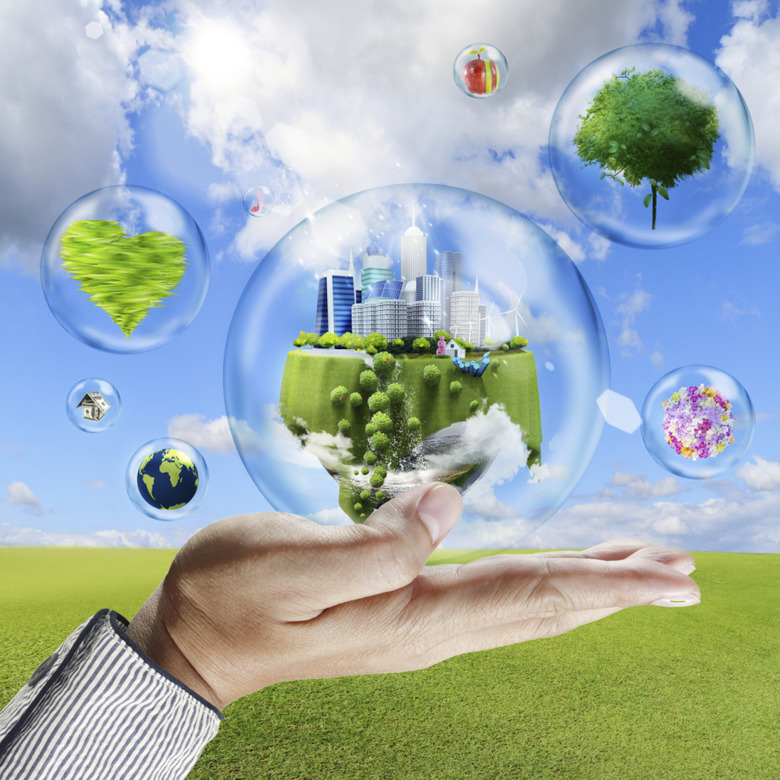How Do Plants Make Oxygen?
Oxygen is a by-product released when plants engage in photosynthesis, the process they use to produce their own food. The chemical events that occur during photosynthesis are complex. The result is that six carbon dioxide molecules and six water molecules become six glucose molecules and six oxygen molecules. The word "photosynthesis" means "making things with light."
The Importance of Air to Plants and Animals
The Importance of Air to Plants and Animals
Without the specific chemical ratios of oxygen, nitrogen, carbon dioxide and other trace gases that make up the air plants and animals on Earth need, nothing would be alive as we know it. As a result of photosynthesis, animals live in a symbiotic relationship with all plant life on Earth. Plants require the carbon dioxide animals expel, while animals require the oxygen plants produce.
Air is so essential to life on Earth that by studying the evolution of oxygenic photosynthesis, Woodward Fischer and associates can identify key events in the history of our planet such as when cyanobacteria and plants first arose. Pretty cool right?
Water and Nutrients
Water and Nutrients
Plant roots absorb water and some nutrients from the ground. Water moves up the plant through the xylem, which is a specialized tissue inside the plant. Water is needed as a means of transporting vital nutrients throughout the plant, and it becomes a reducing agent for the chemistry that occurs during the photosynthesis process. The plant uses water to break down carbon dioxide molecules before they can be reassembled into the sugar substance the plant uses as stored energy.
The Sun's Energy
The Sun's Energy
Photons in sunlight provide the energy required for photosynthesis to occur. The plant captures these photons with light-absorbing pigments, such as chlorophyll and carotenoids. These pigments are also responsible for the green leaves on plants. Chlorophyll and carotenoids do not effectively absorb green or yellow light from the color spectrum. As a result, these colors reflect away from the leaves, making them appear green to our eyes.
Carbon Dioxide
Carbon Dioxide
Plants absorb carbon dioxide from the air through tiny openings, called stomata in the plant's epidermis or outer tissue layer. These microscopic stomata pores open and close as the plant's needs change from absorbing carbon dioxide to expelling oxygen and water. Carbon dioxide is present in the atmosphere from animal exhalation during respiration, as well as from decaying organic matter.
Making Glucose
Making Glucose
Once all the necessary ingredients are in place, the plant tears apart some of the water it has absorbed through the roots and the carbon dioxide it has taken in from the atmosphere. A series of chemical reactions and the sun's energy disassembles the molecules. Another series of chemical reactions, again using the sun's energy, reassemble the resulting atoms into glucose molecules. The plant stores most of this simple sugar for growth and consumes a little during photosynthesis.
For What Process Do Cells Use Oxygen?
For What Process Do Cells Use Oxygen?
Oxygen is a by-product of photosynthesis. The plant does not need the oxygen molecules, so they are expelled through the stomata. Oxygen expelled by plants enters the air to be inhaled by animals and aerobic bacteria.
Animal cells use oxygen for a process called oxidation. Oxidation is vital for breaking down food molecules to extract glucose molecules. The body then uses glucose as an energy source for critical metabolic processes that fuel the body.
Fun Plant Experiments to Try at Home
Fun Plant Experiments to Try at Home
To see plants making oxygen in action pick a green leaf from a plant, place it in a glass of water and leave it in the sun for a couple of hours. When you come back, you will see that little air bubbles have formed on the leaf and around the glass. You may need a magnifying glass to get a good look.
Cite This Article
MLA
Korpella, Robert. "How Do Plants Make Oxygen?" sciencing.com, https://www.sciencing.com/plants-make-oxygen-4923607/. 11 June 2019.
APA
Korpella, Robert. (2019, June 11). How Do Plants Make Oxygen?. sciencing.com. Retrieved from https://www.sciencing.com/plants-make-oxygen-4923607/
Chicago
Korpella, Robert. How Do Plants Make Oxygen? last modified March 24, 2022. https://www.sciencing.com/plants-make-oxygen-4923607/
